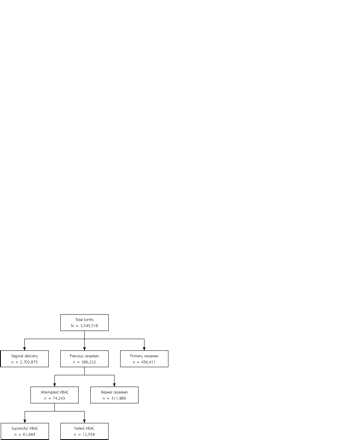Vaginal birth after cesarean in California: before and after a change in guidelines
- PMID: 16735524
- PMCID: PMC1479438
- DOI: 10.1370/afm.544
Vaginal birth after cesarean in California: before and after a change in guidelines
Abstract
Purpose: In 1999 the American College of Obstetricians and Gynecologists (ACOG) adopted more-restrictive guidelines for vaginal birth after cesarean delivery (VBAC). This study assesses trends in VBAC in California and compares neonatal and maternal mortality rates among women attempting VBAC delivery or undergoing repeat cesarean delivery before and after this guideline revision.
Methods: The 1996 through 2002 California Birth Statistical Master Files were used to identify 386,232 California residents who previously gave birth by cesarean delivery and had a singleton birth planned in a California hospital.
Results: Attempted VBAC deliveries decreased significantly from 24% before to 13.5% after guideline revision (P <.001). Neonatal mortality rates per 1,000 live births for attempted VBAC deliveries were not different from repeat cesarean delivery rates among neonates weighing > or =1,500 g in either the study periods 1996 to 1999 or 2000 to 2002. Neonatal mortality rates for attempted VBAC deliveries were higher for repeat cesarean deliveries among neonates weighing <1,500 g in the same periods (attempted VBAC: 1996-1999, 253.2; 95% Poisson confidence interval [CI], 197.7-308.6; 2000-2002, 336.8; CI, 254.3-419.4; repeat cesarean delivery: 1996-1999, 59.1; CI, 48.3-69.9; 2000-2002, 60.5, CI, 48.4-72.5). Maternal death rates per 100,000 live births for attempted VBAC deliveries were similar for both periods (1996-1999, 2.0; CI, 0.1-11.0; 2000-2002, 8.5; CI, 1.0-30.6).
Conclusions: Neonatal and maternal mortality rates did not improve despite increasing rates of repeat cesarean delivery during the years after the ACOG 1999 VBAC guideline revision. Women with infants weighing > or =1,500 g encountered similar neonatal and maternal mortality rates with VBAC or repeat cesarean delivery.
Figures
References
-
- Scott JR. Avoiding labor problems during vaginal birth after cesarean delivery. Clin Obstet Gynecol. 1997;40:533–541. - PubMed
-
- Martin JA, Hamilton BE, Sutton PD, et al. Births: final data for 2002. Natl Vital Stat Rep. 2003;52:1–113. - PubMed
-
- National Institutes of Health. Cesarean childbirth. NIH Consensus Statement Online. Available at: http://odp.od.nih.gov/consensus/cons/027/027_statement.htm#1. Accessed: 23 August 2004.
-
- Healthy People 2000. Washington, DC: US Department of Health and Human Services; 1990.
-
- Vaginal delivery after a previous cesarean birth. Washington, DC: American College of Obstetricians and Gynecologists. ACOG Committee on Obstetric Practice; 1994. Opinion No. 143. - PubMed
MeSH terms
LinkOut - more resources
Full Text Sources


